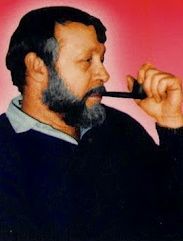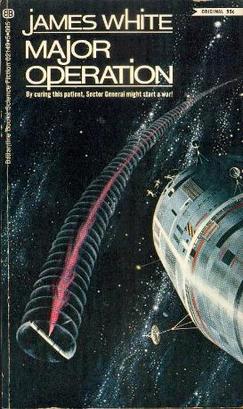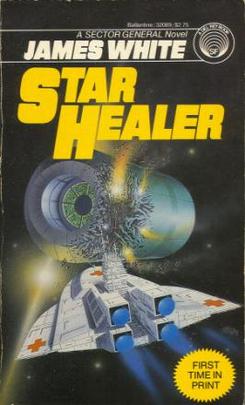
Starship Troopers is a military science fiction novel by American writer Robert A. Heinlein. Written in a few weeks in reaction to the US suspending nuclear tests, the story was first published as a two-part serial in The Magazine of Fantasy & Science Fiction as Starship Soldier, and published as a book by G. P. Putnam's Sons on November 5, 1959.

James White was a Northern Irish author of science fiction novellas, short stories and novels. He was born in Belfast and returned there after spending some early years in Canada. After a few years working in the clothing industry, he worked at Short Brothers Ltd., an aircraft company based in Belfast, from 1965 until taking early retirement in 1984 as a result of diabetes. White married Margaret Sarah Martin, another science fiction fan, in 1955 and the couple had three children. He died of a stroke.

Childhood's End is a 1953 science fiction novel by the British author Arthur C. Clarke. The story follows the peaceful alien invasion of Earth by the mysterious Overlords, whose arrival begins decades of apparent utopia under indirect alien rule, at the cost of human identity and culture.

Algirdas Jonas "Algis" Budrys was a Lithuanian-American science fiction author, editor and critic. He was also known under the pen names Frank Mason, Alger Rome in collaboration with Jerome Bixby, John A. Sentry, William Scarff and Paul Janvier. In the 1990s he was the publisher and editor of the science fiction magazine Tomorrow Speculative Fiction.

Who Goes There? is a 1938 science fiction horror novella by American author John W. Campbell, written under the pen name Don A. Stuart. Its story follows a group of people trapped in a scientific outpost in Antarctica infested by shapeshifting monsters able to absorb and perfectly imitate any living being, including humans. Who Goes There? was first published in the August 1938 issue of Astounding Science Fiction magazine and was also printed as The Thing from Another World, as well as included in the collection by the same title. Its extended, novel version, found in an early manuscript titled Frozen Hell, was finally published in 2019.

Zenna Chlarson Henderson was an American elementary school teacher and science fiction and fantasy author. Her first story was published in The Magazine of Fantasy & Science Fiction in 1951. Her work is cited as pre-feminist, often featuring middle-aged women, children, and their relationships, but with stereotyped gender roles. Many of her stories center around human aliens called "The People", who have special powers. Henderson was nominated for a Hugo Award in 1959 for her novelette Captivity. Science fiction authors Lois McMaster Bujold, Orson Scott Card, Connie Willis, Dale Bailey, and Kathy Tyers have cited her as an influence on their work.

Dwight Graydon "Gray" Morrow was an American illustrator of comics, magazine covers and paperback books. He is co-creator of the Marvel Comics muck-monster the Man-Thing and of DC Comics Old West vigilante El Diablo.

Sector General is a series of twelve science fiction novels and various short stories (1957–1999) by the Northern Irish author James White. The series derives its name from the setting of the majority of the books, the Sector 12 General Hospital, a huge hospital space station located in deep space, designed to treat a wide variety of life forms with a wide range of ailments and life-support requirements, and to house an equally diverse staff. The Hospital was founded to promote peace after humanity's first interstellar war, and in the fourth book the authorities conclude that its emergency services are the most effective way to make peaceful contact with new species.

First contact is a common theme in science fiction about the first meeting between humans and extraterrestrial life, or of any sentient species' first encounter with another one, given they are from different planets or natural satellites. It is closely related to the anthropological idea of first contact.

Star Surgeon is a 1963 science fiction book by Northern Irish author James White, part of his Sector General series.

Major Operation is a 1971 science fiction book by Northern Irish author James White, the third volume in the Sector General series. The book collects together a series of five short stories, all of which were originally published in New Worlds magazine.

Star Healer is a 1985 science fiction book by author James White, part of the Sector General series.

Code Blue – Emergency is a 1987 science fiction novel by Northern Irish writer James White, part of his Sector General series.

Sector General is a 1983 science fiction story collection by author James White and is part of the Sector General series. The book includes four stories.

The Genocidal Healer is a 1992 science fiction novel by Northern Irish author James White, part of his Sector General series. Like late books in the series, it stars an alien. However the protagonist of the early Sector General stories, Dr. Conway, plays an important supporting role, as do other regular characters.

The Galactic Gourmet is a 1996 science fiction book by Northern Irish author James White, part of the Sector General series.

Mind Changer is a 1998 science fiction book by Northern Irish author James White, part of his Sector General series.

Double Contact is a 1999 science fiction book by Irish writer James White, the last in the Sector General series.

"Killdozer!" is a science fiction/horror novella by American writer Theodore Sturgeon, originally published in the magazine Astounding and revised for the 1959 collection Aliens 4.
The Expanse is a series of science fiction novels by James S. A. Corey, the joint pen name of authors Daniel Abraham and Ty Franck. The first novel, Leviathan Wakes, was nominated for the Hugo Award for Best Novel in 2012. The complete series was nominated for the Hugo Award for Best Series in 2017. It later won, following its second nomination for the same award in 2020.



















